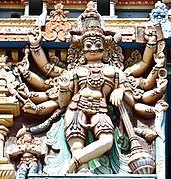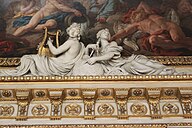Book details
Propitious Esculent: The Potato in World HistoryBy John Reader
stucco
I find I incorporate gneiss, coal, long-threaded moss, fruits,
grains, esculent roots,
And am stucco'd with quadrupeds and birds all over,
And have distanced what is behind me for good reasons,
But call any thing back again when I desire it.
粉飾灰泥(英語:Stucco)是一種裝修塗料,由骨料、粘結劑和水製成。該塗料在濕潤時刷到牆上,乾了後可變得非常堅硬。該塗料通常用在牆壁、天花板、雕塑等地方,作美化裝飾之用,也可以用來覆蓋住金屬、混凝土、土坯、磚等不甚美觀的地方。
Stucco or render is a construction material made of aggregates, a binder, and water. Stucco is applied wet and hardens to a very dense solid. It is used as a decorative coating for walls and ceilings, exterior walls, and as a sculptural and artistic material in architecture. Stucco can be applied on construction materials such as metal, expanded metal lath, concrete, cinder block, or clay brick and adobe for decorative and structural purposes.[1]
In English, "stucco" sometimes refers to a coating for the outside of a building and "plaster" to a coating for interiors; as described below, however, the materials themselves often have little to no differences. Other European languages, notably including Italian, do not have the same distinction; stucco means plaster in Italian and serves for both.[2]
esculent
adjective
- Fit to be eaten: comestible, eatable, edible. Seeingestion.
n. - 可食用物
日本語 (Japanese)
adj. - 食用の
n. - 食用になるもの
propitious
adjective FORMAL ━━ a. 都合のよい ((for, to)); 幸先のよい, (神が)慈悲深い.
likely to result in or showing signs of success:
With the economy in the worst recession for thirty years, it was scarcely the most propitious time to start up a company.
...hours propitious for making bombs. 這是製造炸彈的好時候







沒有留言:
張貼留言